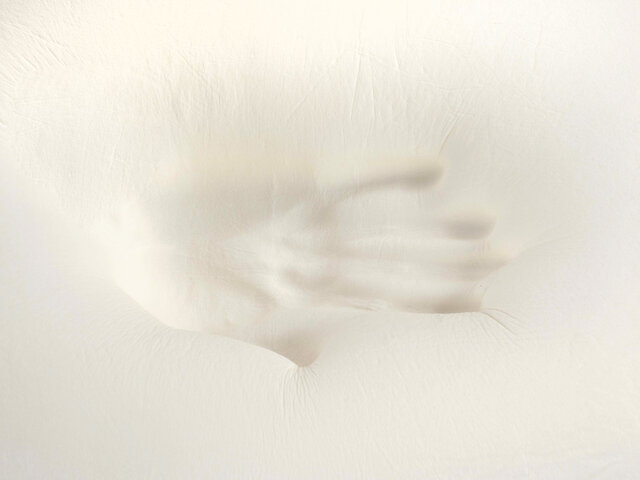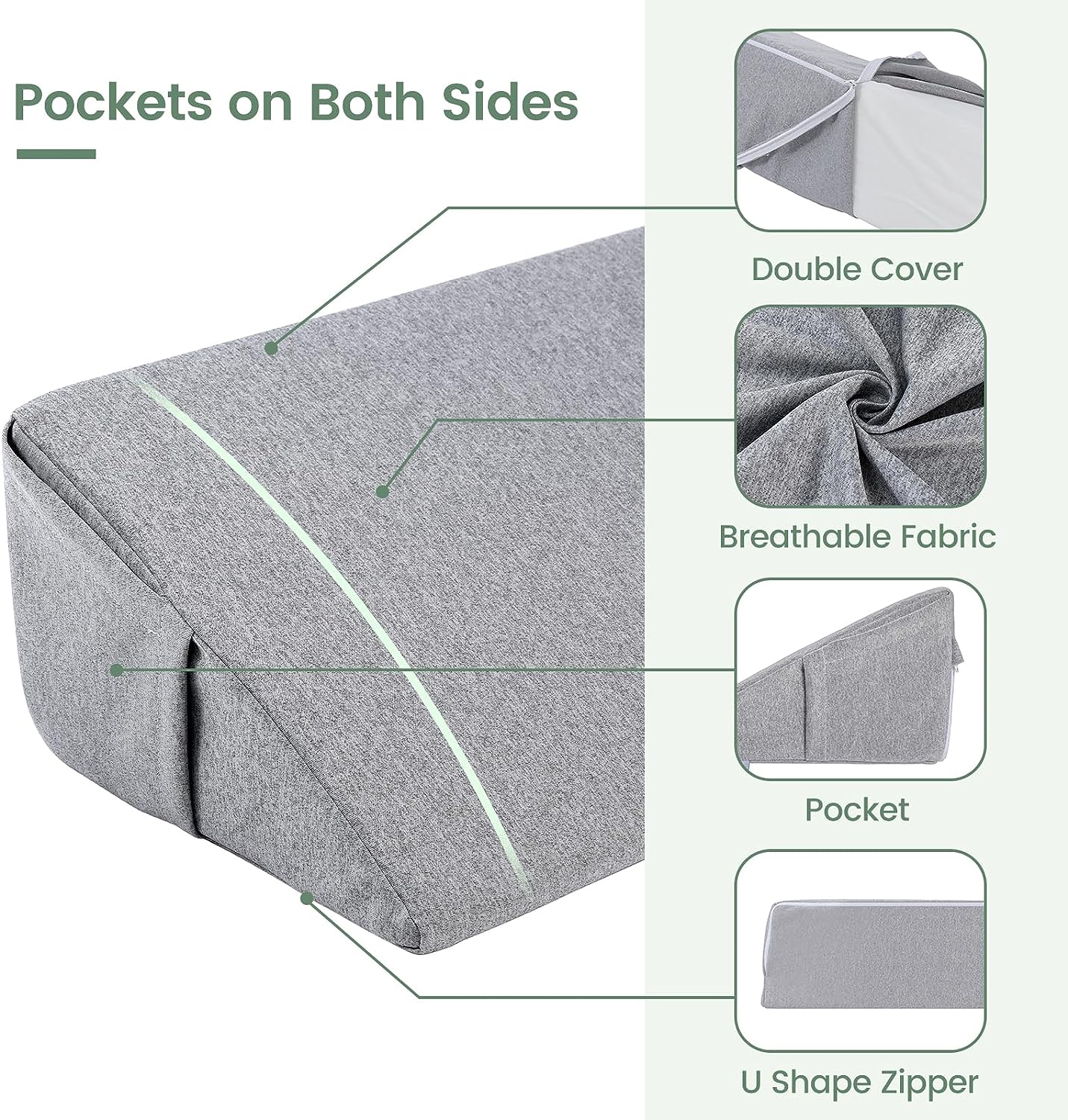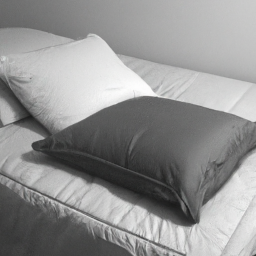Are you struggling to find the perfect material for your wedge pillow? Well, you’re not alone. Many people wonder which material is the best for a wedge pillow and it’s definitely an important consideration. After all, your comfort and quality of sleep depend on it. In this article, we will delve into the different materials used in wedge pillows and help you choose the one that suits your needs the most.
When it comes to choosing the material for a wedge pillow, there are a few options to consider. The most common materials include memory foam, polyester, and latex. Each material has its own unique features and benefits. Memory foam, for example, is known for its ability to contour to your body shape, providing excellent support and pressure relief. Polyester, on the other hand, offers a softer and more affordable option, making it a popular choice for those on a budget. Finally, latex is known for its durability and natural cooling properties, making it a great choice for hot sleepers.
To determine which material is best for your wedge pillow, you’ll need to consider your personal preferences and any specific needs you may have. Do you need extra support for your back? Are you looking for a pillow with cooling properties? By answering these questions, you can narrow down your options and make an informed decision. In the next section, we will provide more in-depth information about each material and their pros and cons, so stay tuned to learn more about finding the perfect material for your wedge pillow.
Introduction
wedge pillows have gained popularity in recent years due to their numerous benefits and the relief they provide for various health conditions. However, with the wide range of materials available, it can be challenging to determine which material is best for a wedge pillow. In this article, we will explore the different materials used in wedge pillows and discuss their advantages and disadvantages, allowing you to make an informed decision when choosing the best material for your needs.
Understanding Wedge Pillows
Definition of a wedge pillow
A wedge pillow is a specially designed pillow that has a triangular shape, with a sloping incline that gradually increases from the thin edge to the thicker edge. This unique shape allows the user to adjust their body’s position, offering support and elevation to different parts of the body.
How wedge pillows are used
Wedge pillows are versatile and can be used in various ways depending on the desired effect. They are commonly used for sleeping, providing support to the head, neck, and upper body. Additionally, they can be used for reading, watching TV, or even to alleviate symptoms of acid reflux, snoring, or sleep apnea.
Benefits of using a wedge pillow
There are several benefits to using a wedge pillow. Firstly, they provide excellent support and alignment for the head, neck, and spine, reducing the risk of discomfort or pain. Wedge pillows also promote better airflow and alleviate snoring or sleep apnea symptoms by keeping the airways open. Moreover, they can improve digestion and alleviate symptoms of acid reflux by keeping the upper body elevated.
Factors to Consider When Choosing a Wedge Pillow
Head and neck support
One of the essential factors to consider when choosing a wedge pillow is the level of support it provides for your head and neck. The pillow should have a gentle incline that allows your head to rest comfortably, maintaining proper alignment with the spine. It should provide adequate support to prevent neck strain or discomfort.
Material and construction
The material and construction of the wedge pillow play a crucial role in determining its comfort and durability. Some common materials used in wedge pillows include memory foam, latex, polyurethane foam, and gel-infused foam. Each material has its own unique characteristics and benefits, which we will explore in further detail.
Firmness level
The firmness level of a wedge pillow is another important aspect to consider. The pillow should be firm enough to provide proper support but also soft enough to ensure comfort. Finding the right balance is essential to ensure a good night’s sleep.
Allergen-free materials
For individuals with allergies or sensitivities, considering allergen-free materials is essential. Look for wedge pillows made from hypoallergenic materials that are resistant to dust mites, molds, and other allergens. This will help ensure a clean and healthy sleep environment.
Different Materials Used in Wedge Pillows
Memory foam
Memory foam is a popular material used in many bedding products, including wedge pillows. It molds to the shape of your body, providing excellent support and relieving pressure points. Memory foam wedge pillows offer superior comfort and help maintain proper spinal alignment, ensuring a good night’s sleep.
Latex
Latex is another common material used in wedge pillows. It is known for its durability and resilience, allowing the pillow to retain its shape and support for an extended period. Latex wedge pillows often have a natural elasticity that provides excellent support while remaining soft and comfortable.
Polyurethane foam
Polyurethane foam is widely used in bedding products due to its affordability and versatility. It offers adequate support, ensuring proper alignment of the head and neck. Polyurethane foam wedge pillows are typically firm and provide good cushioning, making them suitable for those who prefer a more supportive pillow.
Gel-infused foam
Gel-infused foam is a newer material that combines the benefits of memory foam with cooling properties. The gel-infused foam helps regulate body temperature, keeping you cool and comfortable throughout the night. Gel-infused foam wedge pillows are an excellent choice for individuals who tend to sleep hot or experience night sweats.
Advantages and Disadvantages of Memory Foam Wedge Pillows
Benefits of memory foam wedge pillows
Memory foam wedge pillows provide exceptional support and comfort. They contour to your body shape, relieving pressure points and ensuring proper spinal alignment. Memory foam also absorbs motion, reducing disturbances caused by your partner’s movements during sleep. Additionally, memory foam is hypoallergenic, resisting allergens such as dust mites and molds.
Drawbacks of memory foam wedge pillows
One potential drawback of memory foam wedge pillows is that they can retain heat, causing discomfort for individuals who tend to sleep hot. This issue has been addressed with the introduction of gel-infused memory foam, which helps regulate temperature. Some users may also find memory foam wedge pillows to be initially too firm, requiring an adjustment period to get used to the feel.
Advantages and Disadvantages of Latex Wedge Pillows
Benefits of latex wedge pillows
Latex wedge pillows are known for their durability and long-lasting support. They retain their shape well over time and offer excellent responsiveness, adapting to your body movements as you sleep. Latex is a naturally hypoallergenic material, making it perfect for individuals with allergies or sensitivities. Latex pillows also promote breathability, allowing for proper airflow and temperature regulation.
Drawbacks of latex wedge pillows
One potential drawback of latex wedge pillows is their initial smell, which can be noticeable when the pillow is new. However, this smell dissipates over time. Some individuals may also find latex to be a bit too firm for their liking, as it provides strong support. However, softer options are available for those preferring a less firm pillow.
Advantages and Disadvantages of Polyurethane Foam Wedge Pillows
Benefits of polyurethane foam wedge pillows
Polyurethane foam wedge pillows offer excellent support and cushioning. They are firm enough to provide the necessary support to the head, neck, and upper body. Polyurethane foam is also an affordable material, making these pillows more accessible to a wider range of individuals.
Drawbacks of polyurethane foam wedge pillows
One potential drawback of polyurethane foam wedge pillows is their lack of breathability. The foam can trap heat, causing discomfort for those who tend to sleep hot. Additionally, some individuals may find that polyurethane foam retains its shape less effectively over time, leading to a decrease in support and comfort.
Advantages and Disadvantages of Gel-Infused Foam Wedge Pillows
Benefits of gel-infused foam wedge pillows
Gel-infused foam wedge pillows combine the benefits of memory foam with cooling properties. The gel infused into the foam helps regulate body temperature, preventing overheating and promoting a more comfortable sleep environment. Gel-infused foam also provides the same excellent support and contouring as memory foam, alleviating pressure points and ensuring proper spinal alignment.
Drawbacks of gel-infused foam wedge pillows
One potential drawback of gel-infused foam wedge pillows is their slightly higher cost compared to other materials. However, many individuals find that the cooling benefits and overall comfort justify the additional expense. Some users may also find that gel-infused foam wedge pillows are initially firmer, requiring a short adjustment period.
Comparing Material Performance
Durability
When it comes to durability, latex wedge pillows generally outperform other materials. Latex is highly resilient and retains its shape and support over a more extended period. Memory foam, polyurethane foam, and gel-infused foam also offer good durability, but may experience slight sagging over time.
Breathability
In terms of breathability, latex and gel-infused foam wedge pillows are the clear winners. Latex is naturally breathable and allows for proper airflow, preventing heat buildup. Gel-infused foam, as previously mentioned, regulates temperature and promotes coolness throughout the night. Memory foam and polyurethane foam, although comfortable, can trap heat and cause discomfort for individuals who tend to sleep hot.
Support and comfort
All the discussed materials, including memory foam, latex, polyurethane foam, and gel-infused foam, offer excellent support and comfort. However, personal preference plays a significant role in determining which material is the best choice for you. It is recommended to try different materials and assess your comfort level before making a final decision.
Conclusion
Choosing the best material for a wedge pillow ultimately depends on your individual needs and preferences. Consider factors such as head and neck support, material and construction, firmness level, and allergy resistance. Explore materials like memory foam, latex, polyurethane foam, and gel-infused foam, weighing the advantages and disadvantages of each. Remember to prioritize aspects such as durability, breathability, and overall support and comfort. By understanding the characteristics of each material, you can make an informed decision and find the perfect wedge pillow that suits your specific requirements.




